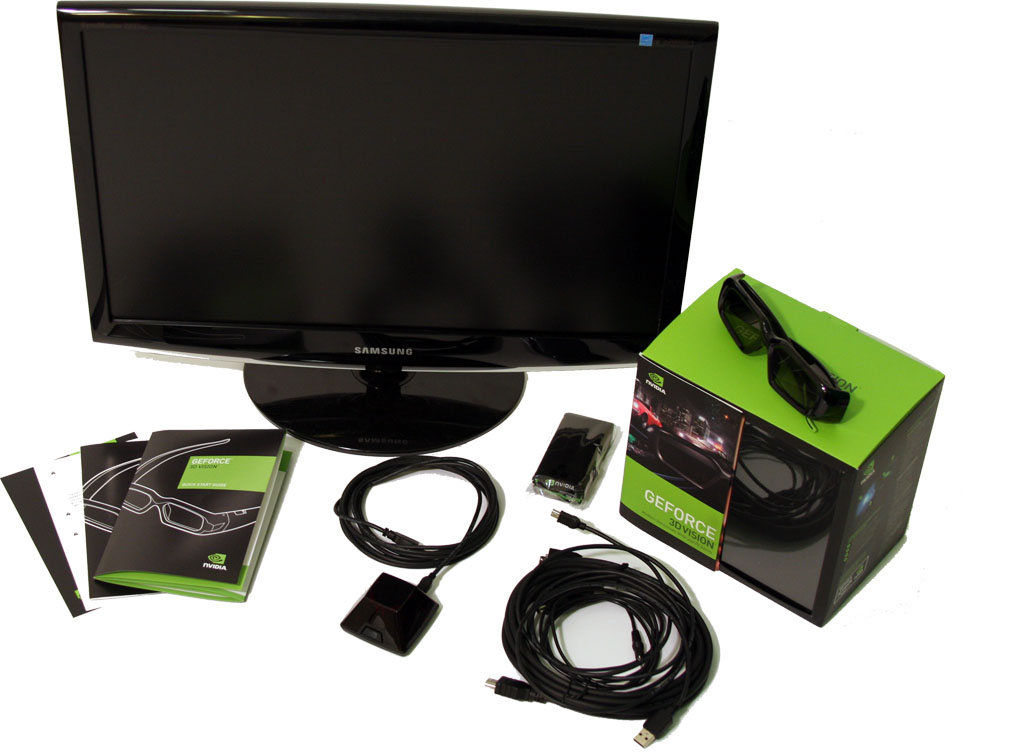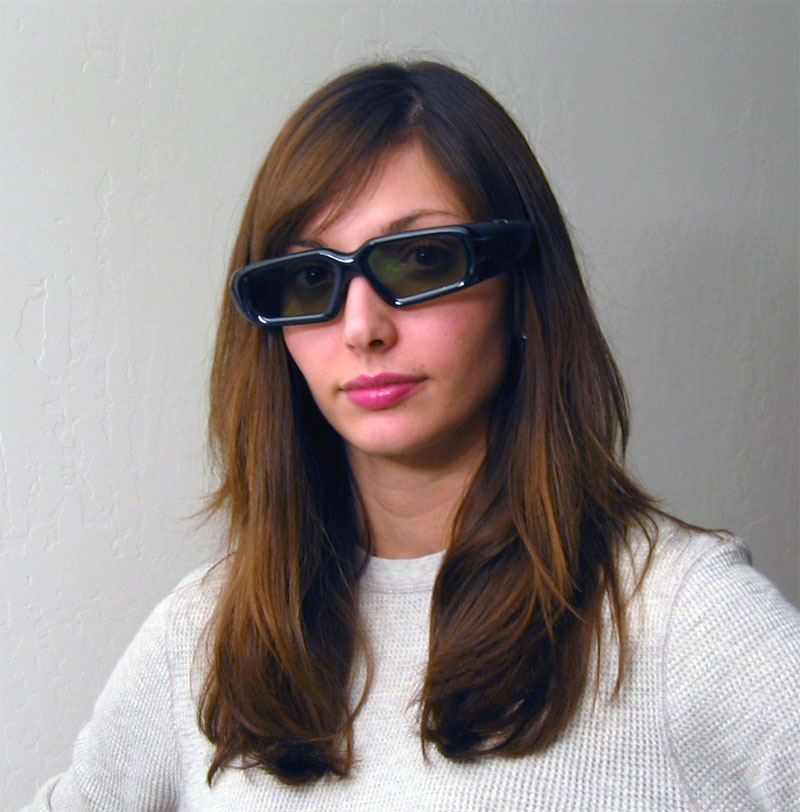GeForce 3D Vision: Gaming Goes Stereo
Finding A Compatible Display
In addition to the GeForce 3D Vision kit, you’ll also need two other pieces of hardware before the technology is truly "enabled:" a compatible graphics card and a compatible display. Unfortunately, this isn’t just a $199 play, as you can see.
The graphics side of things will be easy for many enthusiasts who’re already running Nvidia-based cards. Any of the GTX 200-series boards will work, from the 260 up to the 295. GeForce 9-series cards from the 9600 GT and higher will work. And GeForce 8-series boards from the 8800 GT and up support the technology as well. However, consider those mid-range cards a baseline. In our testing, you’ll see that turning stereo on has a significant impact on performance, so maintaining playable frame rates at native panel resolutions will necessitate a fair bit of GPU power. Bear in mind also that the technology is only supported in one- and two-way configurations. A system boasting 3-way SLI won’t work.
Here’s the tricky part. Because each eye in an active configuration needs 60 Hz to maintain a flicker-free experience, typical 60 Hz LCDs aren’t enough. Just as Elsa’s old Revelators needed a refresh of at least 100 Hz (120 Hz was preferred), so too do Nvidia’s 3D Vision shades require 120 Hz displays. The list of compatible panels is particularly short right now: Samsung’s SyncMaster 22” 2233RZ and ViewSonic’s VX2265wm are the only two LCDs currently cited. But a number of Mitsubishi 1080p DLP TVs also support stereoscopic operation, as does one projector listed in Nvidia’s compatibility sheet.
According to Nvidia, the Samsung display we used for testing is expected to cost somewhere around $399. That’s pretty pricey, considering Samsung’s 22” 2233BW sells for about $240 and Dell’s own E2209W costs as little as $175. For the sake of comparison, the 22” iZ3D LCD, which AMD claims will soon work with its own passive stereoscopic technology as soon as support is built into its drivers, also costs $399. The difference, of course, is that passive glasses cost next-to-nothing. Unfortunately, we’ve yet to see AMD’s solution in action, while the company has briefed us on the technology.
Why not use a 120 Hz LCD TV and the 3D Vision glasses in a theater room? According to Nvidia, none of them include the dual-link DVI inputs needed for 120 Hz, and their HDMI ports only accept a 60 Hz signal. Thus, your options are truly limited when it comes to choosing a compatible display.
Setup
The configuration process bears mention because it has been vastly simplified since the last time we remember using stereoscopic glasses. You unpack the 3D Vision kit, install Nvidia’s software, connect the hardware, and run a wizard that detects your display and tests the hardware’s functionality.
Get Tom's Hardware's best news and in-depth reviews, straight to your inbox.
There’s are 10-foot and six-foot USB cables bundled with the kit, which offer plenty of room to run the IR emitter wherever it needs to go and still recharge the glasses off to the side of your PC.
We will mention that the graphics drivers we used to support GeForce 3D Vision were not the drivers we’d expect to see shipping. They're on a different code path than the drivers under development for the GeForce GTX 295 and, consequently, do not address some of the bug fixes going into that software package. Thus, we ran our tests on a GeForce GTX 280, which we hoped would be a bit more mature. Nvidia assures us that the next official driver release will see fixes for both products and converge into a single version.
-
TheGreatGrapeApe Interesting, but I'm surprised that this came out before an updated and finalized GTX295 review.Reply
nV's recent flurry of 3D stereo-vision and Charlie @ the InQ's pre-emptive bashing of it have been interesting, but it reminds me of Matrox's wonderful surround-view feature, which is great, but it's still niche and will remain so.
Not my cuppa, but at least the tech is moving forward so who knows about the future.
I'm one of those people who see the rainbow effect on Gen3 DLP screens with 360hz colour wheels, so I have a feeling these new glasses won't improve the headaches anymore than the faster wheel solved my rainbow vision. Now synch some shutter glasses on a 480hz plasma... ;)
-
Nice article, but you're forgetting about something...Pc's are not only used for gaming, and if NVidia wants to make this really popular they MUST find a way to make movies work with their glasses.Currently there are very few titles that are in 3D, most are old, and the new ones are expensive, and so far converting a regular movie to stereoscopic 3D is almost impossible, and the quality is not what you'd expect. Also...besides providing their own hardware and a new Vista compatible driver, what did NVidia came up with that surpasses all the other 3D shutter glasses on the market(eDymensional..etc.), giving to account that all the titles you tested work with/the same(look,FPS etc.)with any stereoscopic glasses?Reply
-
cangelini TheGreatGrapeApeInteresting, but I'm surprised that this came out before an updated and finalized GTX295 review.nV's recent flurry of 3D stereo-vision and Charlie @ the InQ's pre-emptive bashing of it have been interesting, but it reminds me of Matrox's wonderful surround-view feature, which is great, but it's still niche and will remain so. Not my cuppa, but at least the tech is moving forward so who knows about the future.I'm one of those people who see the rainbow effect on Gen3 DLP screens with 360hz colour wheels, so I have a feeling these new glasses won't improve the headaches anymore than the faster wheel solved my rainbow vision. Now synch some shutter glasses on a 480hz plasma...Reply
Grape,
It's coming. I sent all of the hardware to Thomas, who has a second GTX 295, which means we'll be able to deliver benchmarks of two 295s versus a pair of X2s and so on down the line. I'm over at CES, so all of this had to be finished up before the show. Should be worth the wait. I'm looking forward to see what four-digits worth of graphics horsepower is capable of, to be sure.
I had the chance to check out Nvidia's competition tonight at the show and am currently working on a news story about it. Not. Impressed. -
enewmen This brings be back to the Asus V6600 GeForce Deluxe card I got in 1999. At that time, the 'Dagoth More Zoological Gardens' with the VR-Glasses was the most awesome sight I've ever seen on a PC. This worked with Ultima9 as well as a nice surpirse :)Reply
I'm surprised I havin't seen (mainstream) 3-D displays without glasses yet. I've seen some samples of this in the past with small screens. -
cangelini Totally remember that myself. That was actually one of the first video cards I ever reviewed =)Reply -
This reminds me that Sony showed a stereo version of Gran Turismo 5 running on a PS3 AND that the RSX is a NVidian board...Reply
-
LCD shutter glasses again??? Really? Yawn. Where are the glasses that beam images directly onto my retinas or even a set of lcd glasses that are actually 2 tiny HD monitors but still light enough to wear comfortably...Reply
-
Fadamor I need to point out an apparent error in nVidia's statement regarding TV's... I purchased a Samsung 40" LCD TV (Model number LN40A650) just prior to the holidays that has 120 Hz HDMI ports (4 of them) AND has 120 Hz refresh rate. So there ARE large screens out there that should be able to support the 3D technology.Reply -
GlItCh017 gmt325ghnice... just one small problem .... what about people who wear glasses ???!!!Reply
I would guess that it fits over glasses.


